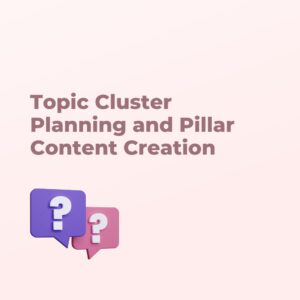Mastering Topic Cluster Planning and Pillar Content Creation: A Blueprint for SEO Authority and Long-Term Growth
Article: Mastering Topic Cluster Planning and Pillar Content Creation
The digital landscape is evolving faster than ever. Businesses are competing for attention in a crowded online marketplace where thousands of new blog posts are published every second. Traditional keyword-based strategies are no longer enough to rank high in search engines or keep readers engaged. Instead, successful brands are shifting toward topic cluster planning and pillar content creation — a structured content strategy that builds authority, improves SEO, and delivers long-term growth.
If you’ve been looking for a way to organize your content, dominate search engine results pages (SERPs), and build meaningful engagement with your audience, this approach is the answer. In this article, we’ll break down the concept of topic clusters and pillar content, explain why they are critical in today’s digital world, and guide you step by step on how to create them for your business.
What Are Topic Clusters and Pillar Content?
A topic cluster is a group of interlinked content pieces that revolve around a central theme. At the heart of this cluster lies the pillar content — a comprehensive, authoritative piece that provides an in-depth overview of the main topic. Supporting it are cluster content pieces that dive deeper into specific subtopics, all linked back to the pillar page.
For example:
-
Pillar Content: “The Ultimate Guide to Digital Marketing”
-
Cluster Content:
-
“SEO Best Practices for Beginners”
-
“How to Use Content Marketing for Growth”
-
“Social Media Strategies for Businesses”
-
“Email Marketing Fundamentals”
-
Together, these form a structured network of content that signals expertise to search engines and provides users with an organized, engaging experience.
Why Topic Clusters and Pillar Content Matter
-
Improved SEO and Higher Rankings
Search engines like Google favor content that is well-organized and interlinked. Topic clusters demonstrate authority on a subject, helping your pages rank higher. -
Better User Experience
Visitors prefer structured content. When they find a comprehensive guide supported by related subtopics, they spend more time on your site, reducing bounce rates. -
Authority Building
By consistently creating valuable pillar and cluster content, your brand becomes the go-to authority in your industry. -
Content Longevity
Pillar content serves as an evergreen resource that can be updated regularly, ensuring it remains relevant for years. -
Efficient Content Strategy
Instead of creating random posts, a cluster strategy ensures every piece contributes to a larger goal, maximizing your content ROI.
Steps to Create Topic Clusters and Pillar Content
1. Identify Core Topics
Start by identifying broad themes relevant to your business or industry. These should be subjects your audience is consistently searching for. For instance, a fitness brand might choose “Healthy Living” as a core theme.
2. Conduct Keyword & Audience Research
Use tools like SEMrush, Ahrefs, or Google Keyword Planner to find long-tail keywords related to your topic. Focus on user intent — what problems are people trying to solve?
For example:
-
Pillar Topic: “Healthy Living Guide”
-
Cluster Keywords: “Healthy meal prep tips,” “10-minute workouts,” “How to sleep better,” etc.
3. Create Pillar Content
Your pillar content should be a comprehensive resource — often 2,000–5,000 words long — covering the broad topic thoroughly. It serves as the “hub” to which all cluster articles link back.
4. Develop Cluster Content
Each cluster post should focus on a specific subtopic. For example:
-
“Top 10 Healthy Snacks for Busy Professionals”
-
“Beginner-Friendly Yoga Routines”
-
“The Role of Sleep in Weight Loss”
These posts should link back to the pillar content, strengthening your internal linking structure.
5. Optimize for SEO
Ensure your pillar and cluster content are optimized with:
-
Clear meta titles & descriptions
-
Relevant headers (H2s & H3s)
-
Internal links between pillar and cluster content
-
External authoritative links
-
Mobile-friendly design and fast loading speed
6. Update and Refresh Regularly
Pillar pages should be evergreen but require periodic updates. Update statistics, add new insights, and refine your content every 6–12 months to maintain authority.
7. Promote Across Channels
Maximize reach by repurposing pillar and cluster content into videos, infographics, social media posts, and email campaigns. This ensures more visibility and better ROI from your efforts.
Real-World Example of Topic Cluster Strategy
Let’s say you run a digital marketing agency. Your pillar content could be:
“The Complete Guide to Digital Marketing for Small Businesses”
Cluster content might include:
-
“SEO Checklist for Small Businesses”
-
“How to Run Effective Facebook Ads”
-
“Email Marketing Tips for Lead Generation”
-
“Why Content Marketing is Key to Growth”
-
“Measuring ROI in Digital Marketing Campaigns”
By interlinking these posts, Google recognizes your site as an authoritative hub for small business digital marketing. Over time, this improves rankings across multiple keywords, driving consistent organic traffic.
Benefits Beyond SEO
While SEO is a significant advantage of topic clusters, the benefits extend further:
-
Stronger Customer Journey: Users move seamlessly from one piece of content to another, deepening their relationship with your brand.
-
Increased Conversions: By strategically placing CTAs in cluster posts, you guide readers toward services, products, or newsletters.
-
Brand Loyalty: Providing consistent, structured value makes customers return to your site as a trusted resource.
Common Mistakes to Avoid
-
Choosing Overly Broad Topics – Avoid subjects too wide to cover in one pillar.
-
Ignoring Updates – Pillar pages that aren’t refreshed lose relevance.
-
Weak Internal Linking – The power of clusters lies in connections; don’t neglect links.
-
Publishing Without Strategy – Random posts dilute authority. Every piece should serve the larger cluster.
The Future of Pillar Content and Clusters
As search engines evolve toward semantic search and AI-driven results, topic clusters will become even more crucial. Search engines are shifting from keywords to understanding intent and context. Businesses that organize their content into clusters will naturally align with this new model, ensuring stronger rankings and better user experiences.
By embracing this strategy now, you set your business up for sustainable growth and lasting digital authority.
Conclusion
Topic cluster planning and pillar content creation are no longer optional — they are the foundation of modern content strategy. They provide structure, boost SEO, enhance user experience, and establish authority in your industry.
When done right, they create a self-sustaining content ecosystem where every piece contributes to your brand’s visibility and credibility. If you want your digital presence to thrive for years to come, it’s time to invest in pillar pages and topic clusters today.
Remember: Trends fade, algorithms shift, but structured knowledge never loses its value.
SEO Keyword Tags with Hashtags:
#TopicClusters
#PillarContent
#SEOAuthority
#ContentStrategy
#DigitalMarketingGrowth
#ContentPlanning
#SearchEngineOptimization
Visit datahome.solutions today and let our Topic Cluster Planning & Pillar Content Services transform your content into a powerful SEO engine that drives growth and authority.












